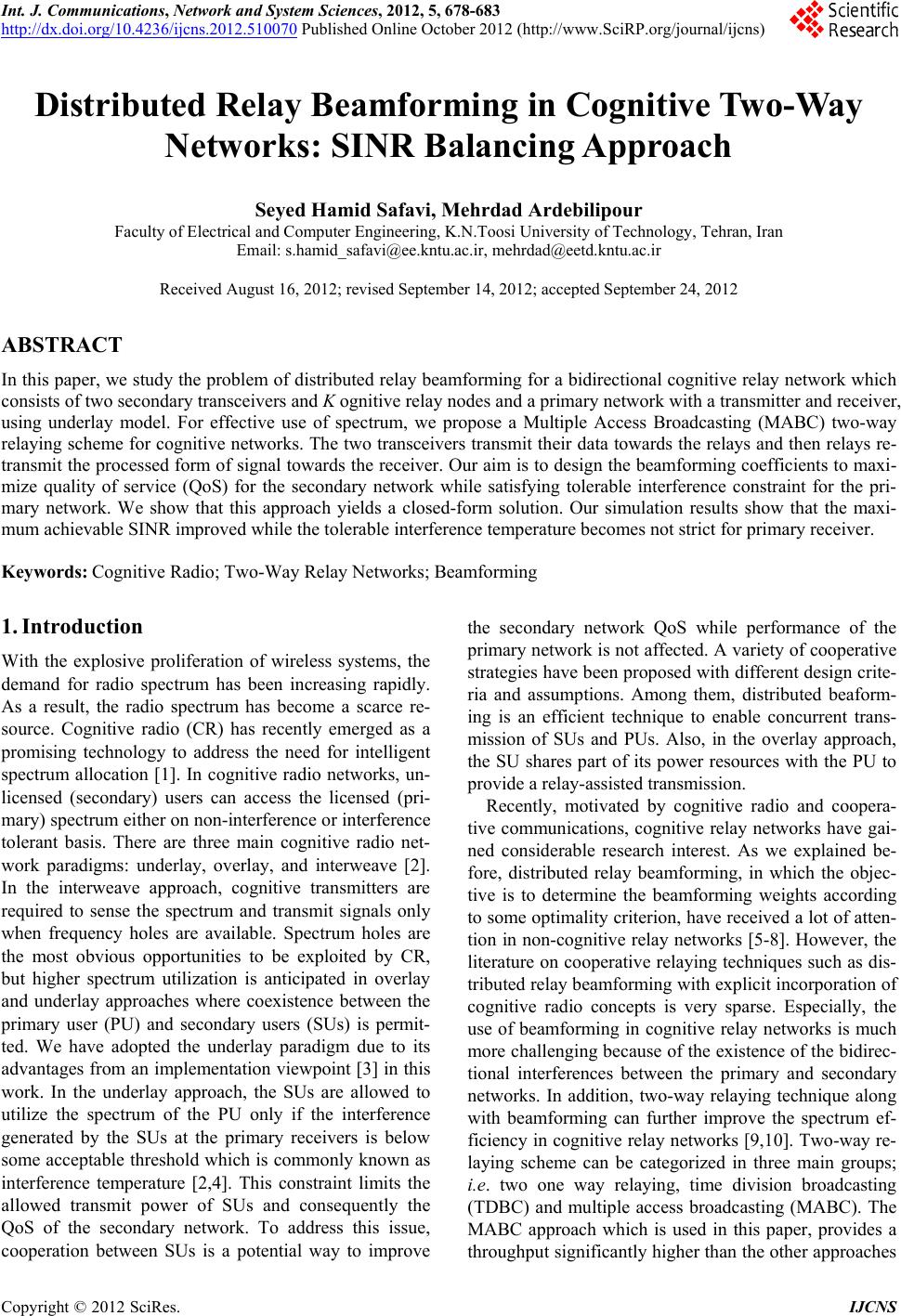
Int. J. Communications, Network and System Sciences, 2012, 5, 678-683
http://dx.doi.org/10.4236/ijcns.2012.510070 Published Online October 2012 (http://www.SciRP.org/journal/ijcns)
Distributed Relay Beamforming in Cognitive Two-Way
Networks: SINR Balancing Approach
Seyed Hamid Safavi, Mehrdad Ardebilipour
Faculty of Electrical and Computer Engineering, K.N.Toosi University of Technology, Tehran, Iran
Email: s.hamid_safavi@ee.kntu.ac.ir, mehrdad@eetd.kntu.ac.ir
Received August 16, 2012; revised September 14, 2012; accepted September 24, 2012
ABSTRACT
In this paper, we study the problem of distributed relay beamforming for a bidirectional cognitive relay netwo rk which
consists of two secondary transceive rs and K ognitive relay nodes and a primary network with a transmitter and receiver,
using underlay model. For effective use of spectrum, we propose a Multiple Access Broadcasting (MABC) two-way
relaying scheme for cogn itive networks. The two transceivers transmit their data towards the relays and then relays re-
transmit the processed form of signal towards the receiver. Our aim is to design the beamforming coefficients to maxi-
mize quality of service (QoS) for the secondary network while satisfying tolerable interference constraint for the pri-
mary network. We show that this approach yields a closed-form solution. Our simulation results show that the maxi-
mum achievable SINR improved while the tolerable interference temperature becomes not strict for primary receiver.
Keywords: Cognitive Radio; Two-Way Relay Networks; Beamforming
1. Introduction
With the explosive proliferation of wireless systems, the
demand for radio spectrum has been increasing rapidly.
As a result, the radio spectrum has become a scarce re-
source. Cognitive radio (CR) has recently emerged as a
promising technology to address the need for intelligent
spectrum allocation [1]. In cognitive radio networks, un-
licensed (secondary) users can access the licensed (pri-
mary) spectrum either on non-interference or interference
tolerant basis. There are three main cognitive radio net-
work paradigms: underlay, overlay, and interweave [2].
In the interweave approach, cognitive transmitters are
required to sense the spectrum and transmit signals only
when frequency holes are available. Spectrum holes are
the most obvious opportunities to be exploited by CR,
but higher spectrum utilization is anticipated in overlay
and underlay approaches where coexistence between the
primary user (PU) and secondary users (SUs) is permit-
ted. We have adopted the underlay paradigm due to its
advantages from an implementation viewpoint [3] in this
work. In the underlay approach, the SUs are allowed to
utilize the spectrum of the PU only if the interference
generated by the SUs at the primary receivers is below
some acceptable threshold which is commonly known as
interference temperature [2,4]. This constraint limits the
allowed transmit power of SUs and consequently the
QoS of the secondary network. To address this issue,
cooperation between SUs is a potential way to improve
the secondary network QoS while performance of the
primary network is not affected. A variety of cooperative
strategies have been proposed with different design crite-
ria and assumptions. Among them, distributed beaform-
ing is an efficient technique to enable concurrent trans-
mission of SUs and PUs. Also, in the overlay approach,
the SU shares part of its power resources with the PU to
provide a relay-assisted transmission.
Recently, motivated by cognitive radio and coopera-
tive communications, cognitive relay networks have gai-
ned considerable research interest. As we explained be-
fore, distributed relay beamforming, in which the objec-
tive is to determine the beamforming weights according
to some optimality criterion, have received a lot of atten-
tion in non-cognitive relay networks [5-8]. However, the
literature on cooperativ e relaying techniques such as dis-
tributed relay beamforming with explicit in corpor ation of
cognitive radio concepts is very sparse. Especially, the
use of beamforming in cognitive relay networks is much
more challenging because of the existence of the bidirec-
tional interferences between the primary and secondary
networks. In addition, two-way relaying technique along
with beamforming can further improve the spectrum ef-
ficiency in cognitive relay networks [9,1 0]. Two-way re-
laying scheme can be categorized in three main groups;
i.e. two one way relaying, time division broadcasting
(TDBC) and multiple access broadcasting (MABC). The
MABC approach which is used in this paper, provides a
throughput sign ificantly higher than the other app roaches
C
opyright © 2012 SciRes. IJCNS